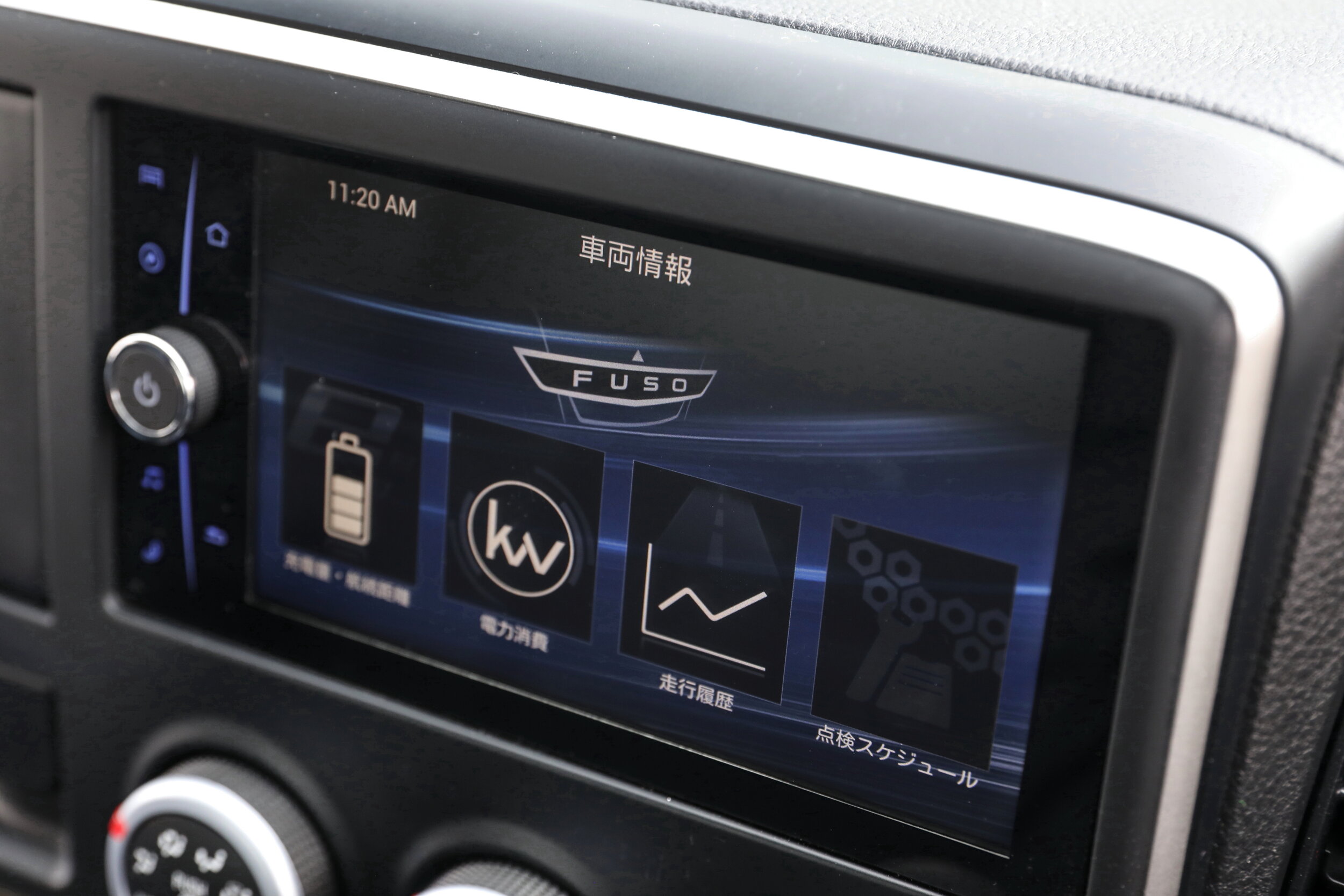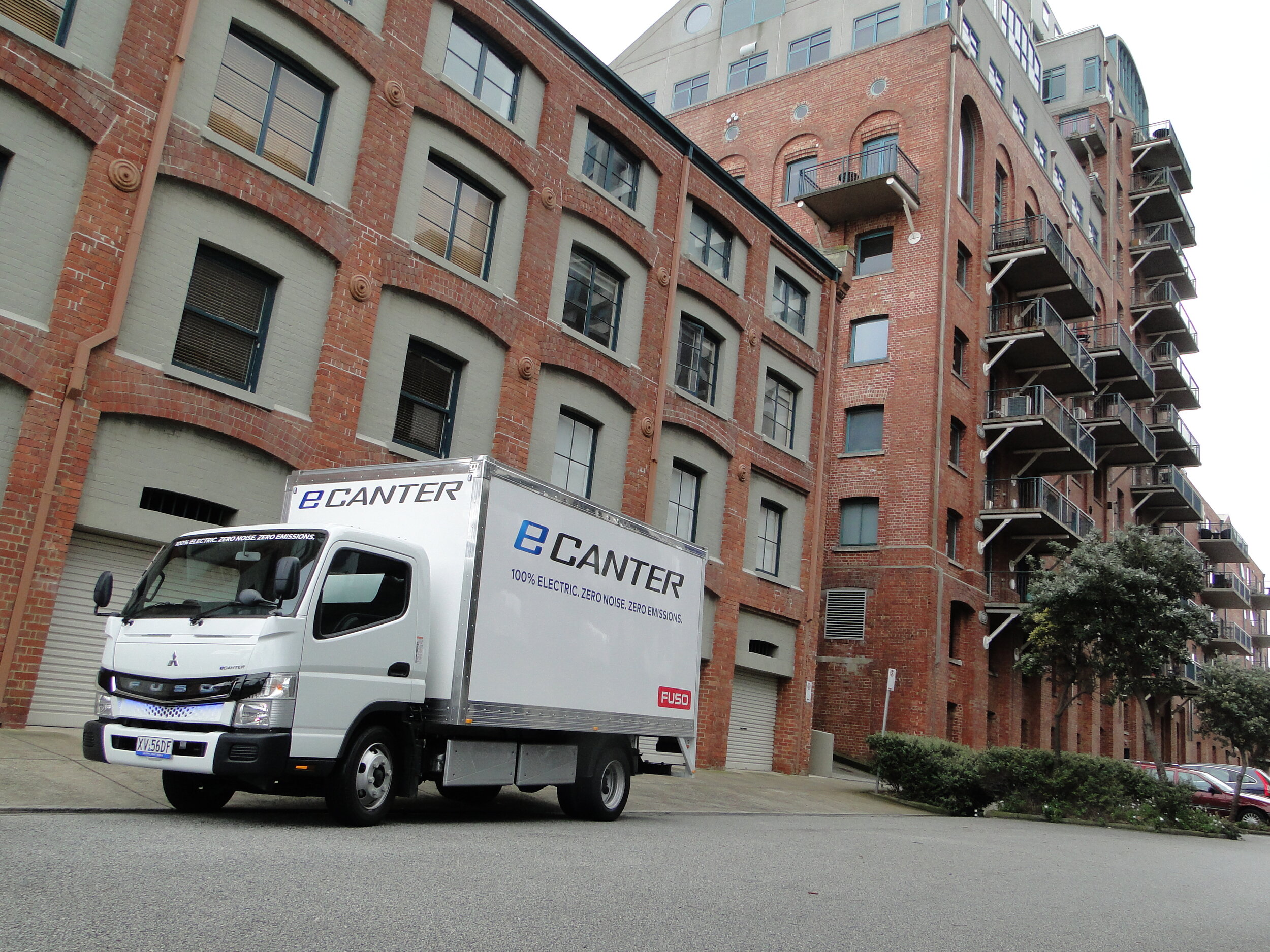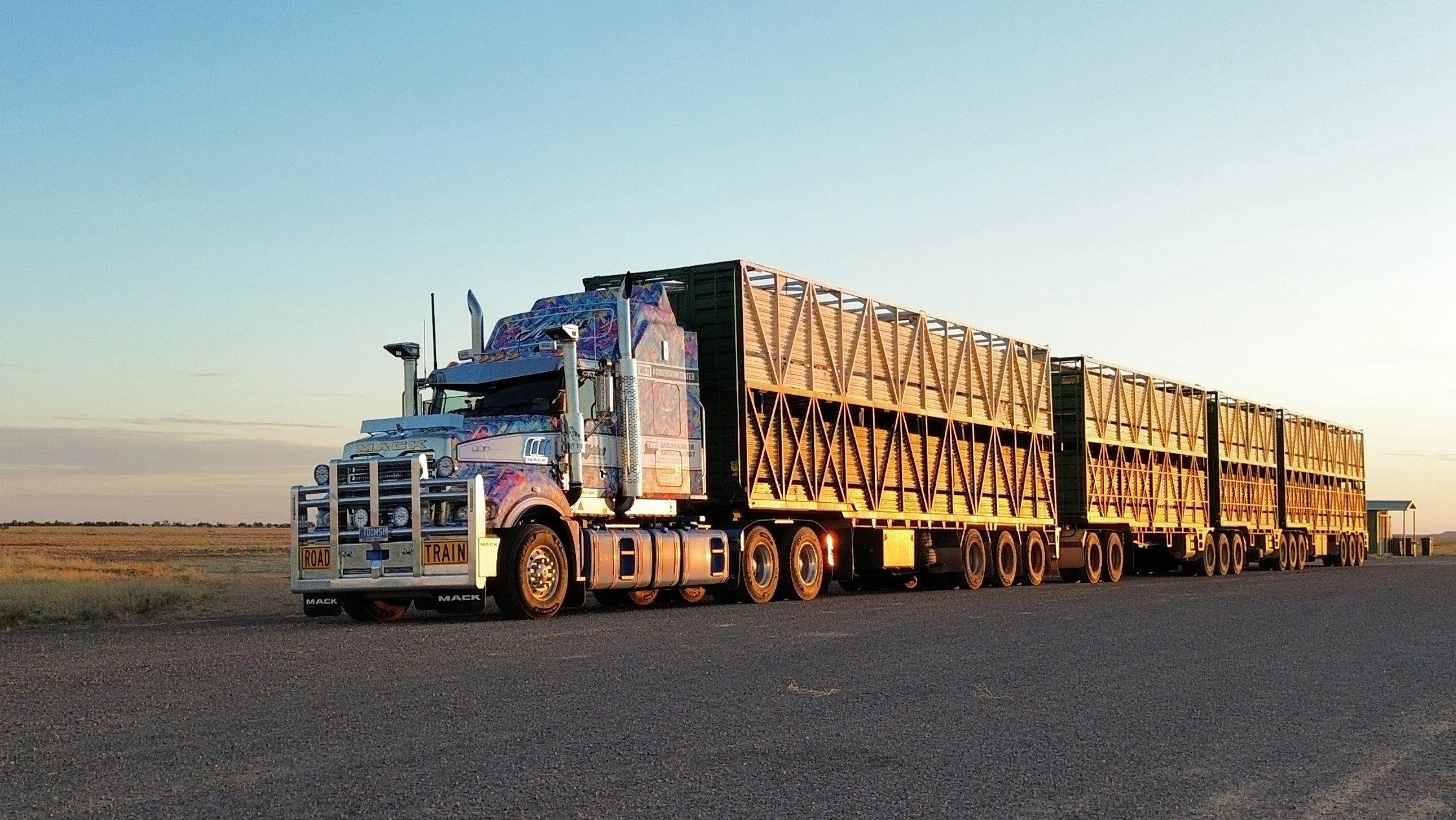Switching on…
All-electric Fuso eCanter charges into Australian market.
Here at Truckin with Kermie we don’t discriminate, we’ll talk about any and all trucks – big, small and in-between. One of my most enjoyable recent test drives of a truck was surprisingly, not a big-banger but an all-electric vehicle by Fuso, last year. That was a trial vehicle to dip their toe into Australian waters.
It has now been confirmed that Fuso will introduce the world’s first all-electric light truck in Australia next February.
Daimler’s Daniel Whitehead with the company’s latest baby
Developed from the ground-up using Daimler’s research and development might and extensively tested in harsh environments, the near-silent eCanter, which produces zero exhaust pipe emissions, was first introduced in 2017 and is currently operating in the United States, Europe and Japan.
Like all Canter 4x2 models, the eCanter is equipped with a long list of unmatched safety features including Advanced Emergency Braking, Lane Departure Warning, Electronic Stability Control, Hill Start assist, reversing camera and driver and passenger airbags. Fuso includes these key safety features at no extra cost to the customer…
Now, why did I find the Fuso eCanter so entertaining? Read on…
eCanter - “Fully Sick, Bro.”
Faster than a speeding bullet! More powerful than a locomotive! Able to leap tall buildings….well, maybe not that.
If I were writing for a car mag you may think that I’m leading into a story on the latest Ferrari or Shelby Ford F150 Cobra, but no. This is a story of a truck – a medium rigid truck with no pistons….or gears….or sound. This is the Fuso eCanter!
One of the nice things about this job is that one gets (he says in his best Queen’s English) to drive product that is not yet available to the general trucking public. And so it was that I was one of the few outsiders to be invited to hop inside the cab of the fully electric eCanter.
Fact is that this vehicle will probably never – certainly not in the foreseeable future - be available to just anyone. Indeed, when it comes onto the Australian market you won’t be able to buy it at all. Leasing will be the only option available.
Let’s get into the nitty gritty. From the outside this is no different to any other 71/2 ton Canter Pantech. One of these would pass you on the street and you’d not give it a second glance – not only because it looks the same as its siblings, but because you simply wouldn’t hear it coming (or going).
The instrument panel contains two round dials, the left being the speedo with ‘fuel’ gauge inset, and the right a circle with a line around the circumference: one third of which is green (charging), one third blue (economy) and the final third white (chewing the ‘juice’). Inset into this dial is a pic of a plug that shows the vehicle is on charge. In between is a digital screen with various essential information.
Keeping that needle on the RH Gauge around here becomes a competition with yourself
On the dash is a second screen which shows a battery with the available predicted range. The screen also doubles as a Sat Nav and radio. Being in Japanese we got as far as tuning the radio into the ABC and left it there.
Yep. Australian models will be easier to read.
Below this is the aircon which delivers brass monkeys, and the ‘gearstick’. Park, Neutral and Reverse and across to the left for Drive. The indicator stalk is in the logical position on the right of the steering column. On the left is the column for the wipers which doubles as the Regenerative (or Foundation) Brake. In practical terms this feels very much like the retarding brake found on modern autos in big bangers but as it hauls you up (quickly) it is throwing power back into the battery bank. Otherwise the cab is pretty much standard Canter, save for a nice piano-black strip across the bottom of the light and dark grey dash for an added touch of class.
This is the first Series-production electric truck in the world, developed and tested by Daimler Corp over a number of years. It started life as the Canter E-Cell prototype that operated in its first public test program in 2015.
This Series 1.1 has been on the market in Japan, Europe and North America for the last two years, being leased to such companies as DHL, 7/11, and UPS. The city of Lisbon in Portugal is also using them. Our drive is a prototype vehicle, here purely for evaluation.
Mechanically the 1.1 has the electric motor about halfway down the driveline, flanked by battery banks and driving through a standard diff. The coming Series 2.0 will have an electric transaxle set up, similar to a Tesla, where the motor will be integrated into the axle. That will free up space for more batteries if distance is deemed more important than the consequently reduced payload.
This eCanter weighs 41/2 tons, leaving a 3 ton payload. The six Daimler-sourced, liquid cooled, lithium ion batteries total 360v, 82.8Wh, which doesn’t mean much to someone raised on horsepower/Kw.
This is the environment in which the eCanter will likely live
So let’s go for a spin. Turn on the key and there are some quiet background whizzes and clicks as a light on the dash tells you to wait for a couple of seconds while the truck’s brain gets into gear. Move the gear knob into Drive and away we go. We leave – oh so quietly - from Daimler HQ in Mulgrave (Vic) out onto the Monash carpark to head into the inner city – where a truck such as this will probably spend it’s working life – and surrounding ‘burbs, then back down the Beach Rd to base.
The truck tells me that we have a range of 90km and, trying to be super conscientious, I keep a constant eye on the right dial keeping the needle as close to the first (green) band as possible. ‘Quiet’ is the name of the game. The only sounds intruding are the air-con fan switching in and out and the distant thrum of the Bridgestone Eco tyres fitted to the vehicle. Oh, and other traffic! Normally you’d pay no heed, but you get so serene in your own little electric world that the noisy buggers beside you actually start to give you the irrits. The cab in this truck is well insulated but I reckon double glazed windows should be offered as an option.
We hit the city and the consequent traffic lights. Beside me is a VT Holden V8 burbling away - P-plates, Doof-Doof and pimples on the driver’s cheeks. Lights change to green and Boy Racer is off! I can’t help myself. As he squeals off down the road I put my electric pedal to the metal in the 4 plus ton Pantech. In no time I’m beside, and then past him. Wow! Just, Wow! We pull up at the next set of lights and there I am with a grin from ear to ear and there’s Boy Racer looking across in astonishment. Hahaha.
My host, Romesh, the Senior Manager, Product Management and Engineering at Fuso, looks at me with a smile. “You like?”
“Fully sick, Bro,” I reply.
Being electric, full torque (ideal for heavy loads) is available from the get-go and boy, do you notice it. Of course this is not the way to drive these things because that Available Distance gauge is going to drop alarmingly.
Driving around the streets of Port Melbourne, the biggest problem became watching people not watching you, because they don’t hear you coming. I can see a future scenario where a council or government demands that you have to have an engine-like sound emitting from your vehicle so the pedestrians would know that you were coming. Maybe we could call it the ‘Get-Your-Face-Out-Of-The-Phone’ alert.
The source of the power
At this stage we have driven over twice the mileage (29.6km) compared to ‘distance consumed’ (12km) according to the gauge, so Fuso have been ultra conservative in this respect. With careful driving I’d think you could go close to doubling the projected range.
The regenerative brake lever is so effective that you hardly use the foot brake until the last few feet. It quickly becomes habit to flick it forward to feed power back into the system. Those heavy batteries aid centre of gravity and the truck sits on the road very well. In addition, the turning circle is as tight as, making the eCanter ideal for city back lanes, residential estates and so forth which is where it will live.
They would be an ideal vehicle for night work in built up areas where silence is golden. I’m old enough to remember the Dunny Cart Man and the noise of his truck every Thursday morning at 4am. Wish he’d had one of these.
The fact remains that these are a specific vehicle built for a specific purpose which is delivery in high density areas. Australia Post will be trialling some in the near future. They would be good for large truck companies to redistribute from base.
The other part of the equation is the necessity of a fast charger which won’t come cheaply. These chargers can ‘fill ‘er up’ in under two hours. Large businesses will be able to amortise the cost but a single player, not so much. A savvy operator could have battery storage, solar panels and wind and could theoretically run this thing for the registration and insurance costs alone. In the ‘Dunny Cart’ situation for example, the truck could be on charge via solar throughout the day.
We headed down Beach Road where trucks are banned because of noise. I so wanted to be pulled up, but alas, it was not to be. With plenty of charge left in the batteries I was able to further explore the acceleration of the eCanter and thoroughly enjoyed the looks on fellow motorist’s faces as we breezed ahead of them from light to light. Maybe Fuso could ask their associated company, Mercedes Benz, if they could borrow their ‘AMG’ go-fast badges.
“Fill ‘er up please.”
Addressing ‘the elephant in the room’, you are going to read this article and say, “90-130 odd kilometre range? You’re joking aren’t you?” Remember these are designed to work close to base in high density areas. I was surprised that in a period of an hour we had only travelled around 20km – and we weren’t stopping to deliver a parcel to every second address. In that period we had only dropped 10km in range. If you need to top up to finish your run, a 40 minute lunch break back at base is going to recharge up to 80% capacity. This is a horses-for-courses machine.
Seriously, would I have one? Absolutely, if I was big enough and in the business of delivering in a built-up urban area. Obviously you’re helping the environment and whilst the current government doesn’t seem to care much, many people across the political divide do. It’s a case of when and not if broad-based infrastructure comes in to support these things.
Companies like Australia Post are going to be quite happy to put that sort of auxiliary infrastructure in for themselves because it just makes fiscal sense. At their scale of operation, the running costs are going to put the ledger in the black in no time at all.
It’s not just fuel. There’s no oil changes and the brakes are going to last much, much longer. There is no gearbox to be stuffed by exuberant and non-caring employees. The old internal combustion engine needs constant maintenance, particularly in the stop/start environment for which the eCanter is intended, whereas electric motors just keep on keeping on.
At the end of the day we’re talking about something which is inevitable and Fuso, with their eCanter is at the forefront of this type of vehicle.
“Fully Electric? Fully sick Bro!”
More Blog Posts You Will Love
More From In-depth
Got something to say? Say it here!
truckinwithkermie.com is for YOU and about YOU. We’d love to hear your stories. There are a number of ways to get in touch with us:
kermie@truckinwithkermie.com
(+61) 0418 139 415

























